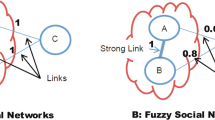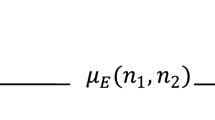Abstract
The identification of a central node in a network is one of the important tasks of social networks. Nowadays, the central node helps grow online businesses, spread news, advertisements, etc. Existing methods for centrality measurement capture the direct reachability of the node. In social networks, parameters such as relationships among the nodes are generally uncertain. This uncertainty can be tracked using either probability theory or fuzzy theory. In this article, the fuzzy theory, particularly the neutrosophic fuzzy theory, is used because, in this concept, more information, such as true values, falsity and indeterminacy, is incorporated. Thus, the representation of social networks using neutrosophic graphs gives more information compared to fuzzy graphs. This study introduces a new form of centrality measurement using a neutrosophic graph. This measurement considers the different merits of individuals in a network. Individual merits (self-weight) have been included in the proposed method. A small network of university faculty members has been considered to illustrate the problem and to demonstrate the potential fields of application of this new method of centrality measurement.





Similar content being viewed by others
Data availability
Enquiries about data availability should be directed to the authors.
References
Agneessens F, Borgatti SP, Everett MG (2017) Geodesic based centrality: unifying the local and the global. Soc Netw 49:12–26
Ahajjam S, Badir H (2018) Identification of influential spreaders in complex networks using hybrid rank algorithm. Sci Rep 8(1):11932
Akram M (2016) Single-valued neutrosophic planer graph. Int J Algebra Stat 5:157–167
Akram M, Siddique S (2017) Neutrosophic competition graphs with applications. J Intell Fuzzy Syst 33(2):921–935
Akram M, Sitara M (2018) Novel applications of single-valued neutrosophic graph structures in decision-making. J Appl Math Comput 56(1–2):501–532
Albert R, Jeong H, Barabasi AL (1999) Diameter of the world wide web. Nature 401:130–131
Andrade RL, Rêgob LC (2019) p-means centrality. Commun Nonlinear Sci Numer Simul 68:41–55
Andrushia AD, Thangarajan R (2015) Visual attention-based leukocyte image segmentation using extreme learning machine. Int J Adv Intell Paradig 7(2):172–186
Andrushia AD, Thangarajan R (2017) An efficient visual saliency detection model based on Ripplet transform. Sādhanā 42(5):671–685
Andrushia AD, Thangarajan R (2020) RTS-ELM: an approach for saliency-directed image segmentation with ripplet transform. Pattern Anal Appl 23(1):385–397
Bae J, Kim S (2014) Identifying and ranking influential spreaders in complex networks by neighborhood coreness. Physica A 395:549–559
Bavelas A (1948) A mathematical model for group structures. Appl Anthropol 7:16–30
Bavelas A (1950) Communication patterns in task oriented groups. J Acoust Soc Am 22:725–730
Bonacich P (2007) Some unique properties of eigenvector centrality. Soc Netw 29:555–564
Broumi S, Talea M, Bakali A, Smarandache F (2016) Single Valued Neutrosophic Graphs. J New Theory 10:86–101
Broumi S, Ullah K, Mahmood T, Talea M, Bakali A, Smarandache F, Lathamaheswari M (2021) Trends on extension and applications of neutrosophic graphs to robots. In: Toward humanoid robots: the role of fuzzy sets. Springer, Cham. pp 277–308
Das K, Samanta S, Pal M (2018) Study on centrality measures in social networks: a survey. Soc Netw Anal Min 8(13):1–11
Estrada E, Rodriguez-Velazquez JA (2005) Subgraph centrality in complex networks. Phys Rev 71:056103
Fei Y (2020) Study on neutrosophic graph with application in wireless network. CAAI Trans Intell Technol 5(4):301–307
Freeman LC (1978) Centrality in social networks conceptual clarification. Soc Netw 1:215–239
Hu R-J, Li Q, Zhang Y-G, Ma WC (2015) Centrality measures in directed fuzzy social networks. Fuzzy Inf Eng 7(1):115–128
Katz L (1953) A new status index derived from sociometric analysis. Psychometrika 18(1):39–43
Kauffman A (1973) Introduction a la Theorie des Sous-emsembles Flous. Masson et Cie Editeurs, Paris
Ling M, Chuang M, Zhang H, Wang B (2016) Identifying influential spreaders in complex networks based on gravity formula. Physica A 451:205–212. https://doi.org/10.1016/j.physa.2015.12.162
Lu L, Zhang YC, Yeung CH, Zhou T (2011) Leaders in social networks, the delicious case. PLoS ONE 6(6):e21202. https://doi.org/10.1371/journal.pone.0021202
Lu D, Li Q, Liao SS (2012) A graph-based action network framework to identify prestigious members through member’s prestige evolution. Decis Support Syst 53(1):44–54
Lv Z, Zhao N, Xiong F, Chen N (2019) A novel measure of identifying influential nodes in complex networks. Physica A 523:488–497
Mahapatra R, Samanta S, Pal M, Xin Q (2019) RSM index: a new way of link prediction in social networks. J Intell Fuzzy Syst 37:2137–2151. https://doi.org/10.3233/JIFS-181452
Mahapatra R, Samanta S, Allahviranloo T, Pal M (2019) Radio fuzzy graphs and assignment of frequency in radio stations. Comput Appl Math 38:117. https://doi.org/10.1007/s40314-019-0888-3
Mahapatra R, Samanta S, Pal M (2020) Applications of edge colouring of fuzzy graphs. Informatica 31(2):313–330. https://doi.org/10.15388/20-INFOR403
Mahapatra R, Samanta S, Pal M (2020) Generalized neutrosophic planar graphs and its application. J Appl Math Comput 65:693–712. https://doi.org/10.1007/s12190-020-01411-x
Mahapatra R, Samanta S, Pal M, Xin Q (2020) Link prediction in social networks by neutrosophic graph. Int J Comput Intell Syst 13(1):1699–1713. https://doi.org/10.2991/ijcis.d.201015.002
Mahapatra R, Samanta S, Bhadoria R, Pal M, Allahviranloo T, Pandey B (2020) A graph networks based quality control model for packaged food smart traceability and communication. Eur J Mol Clin Med 7(6):2830–2848
Mahapatra R, Samanta S, Pal M, Lee J, Khan S, Naseem U, Bhadoria R (2021) Colouring of COVID-19 affected region based on fuzzy directed graphs. Comput Mater Contin 68(1):1219–1233. https://doi.org/10.32604/cmc.2021.015590
Mahapatra R, Samanta S, Pal M (2022) Edge colouring of neutrosophic graphs and its application in detection of phishing website. Discrete Dyn Nat Soc Article ID 1149724, 8. https://doi.org/10.1155/2022/1149724
Newman M (2005) A measure of betweenness centrality based on random walks. Soc Netw 27(1):39–54
Nieminen J (1974) On the centrality in a graph. Scand J Psychol 15:322–336
Panfeng L, Li L, Shiyu F, Yukai Y (2021) Identifying influential nodes in social networks: a voting approach. Chaos Solitons Fractals 52:111309
Parand FA, Rahimi H, Gorzin M (2016) Combining fuzzy logic and eigenvector centrality measure in social network analysis. Physica A 459:24–31
Rosenfeld A (1975) Fuzzy graph. In: Zadeh LA, Fu KS, Shimura M (eds) Fuzzy sets and their applications. Academic Press, New York, pp 77–95
Sabidussi G (1966) The centrality index of a graph. Psychometrika 31(4):581–603
Salavaty A, Ramialison M, Currie PD (2020) Integrated value of influence: an integrative method for the identification of the most influential nodes within networks. Patterns 1:100052
Samanta S, Pal M (2015) Fuzzy Planar Graphs. IEEE Trans Fuzzy Syst 23(6):1936–1942
Samanta S, Dubey VK, Sarkar B (2020) Measure of influences in social networks. Appl Soft Comput. https://doi.org/10.1016/j.asoc.2020.106858
Samanta S, Dubey VK, Das K (2022) Coopetition bunch graphs: competition and cooperation on COVID19 research. Inf Sci 589:1–33
Shaw ME (1954) Group structure and the behavior of individuals in small groups. J Psychol 38:139–149
Sheng J, Dai J, Wang B, Duan G, Long J, Zhang J, Guan K, Hu S, Chen L, Guan W (2020) Identifying influential nodes in complex networks based on global and local structure. Physica A 541:123262
Shimbel A (1953) Structural parameters of communication networks. Bull Math Biophys 15(4):501–507
Wang J et al (2017) A novel weight neighborhood centrality algorithm for identifying influential spreaders in complex networks. Physica A S0378–4371(17):30121–30128
Wang Q, Gong ZT (2020) Structural centrality in fuzzy social networks based on fuzzy hypergraph theory. Comput Math Organ Theory 26:236–254
Wang P, Lu J, Yu X (2014) Identification of important nodes in directed biological networks: a network motif approach. PLoS ONE 9(8):e106132
Wang X, Slamu W, Guo W, Wang S, Ren Y (2022) A novel semi local measure of identifying influential nodes in complex networks. Chaos Solitons Fractals 158:112037
Zareie A, Sheikhahmadi A (2019) EHC: extended H-index centrality measure for identification of users’ spreading influence in complex networks. Physica A 514:141–155
Zareie A, Sheikhahmadi A, Jalili M (2020) Identification of influential users in social network using gray wolf optimization algorithm. Expert Syst Appl. https://doi.org/10.1016/j.eswa.2019.112971
Funding
The authors have not disclosed any funding.
Author information
Authors and Affiliations
Corresponding author
Ethics declarations
Conflict of interest
The authors declare that they have no potential conflict of interest.
Ethical approval
This article does not contain any study performed on humans or animals by the authors.
Informed consent
Informed consent was obtained from all individual participants included in the study.
Additional information
Publisher's Note
Springer Nature remains neutral with regard to jurisdictional claims in published maps and institutional affiliations.
Rights and permissions
Springer Nature or its licensor (e.g. a society or other partner) holds exclusive rights to this article under a publishing agreement with the author(s) or other rightsholder(s); author self-archiving of the accepted manuscript version of this article is solely governed by the terms of such publishing agreement and applicable law.
About this article
Cite this article
Mahapatra, R., Samanta, S. & Pal, M. Detecting influential node in a network using neutrosophic graph and its application. Soft Comput 27, 9247–9260 (2023). https://doi.org/10.1007/s00500-023-08234-5
Accepted:
Published:
Issue Date:
DOI: https://doi.org/10.1007/s00500-023-08234-5




